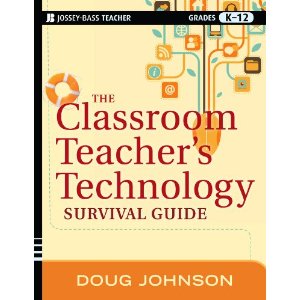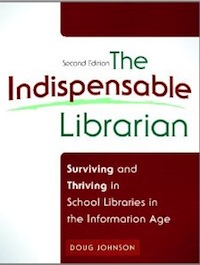Librarians 2.0
Librarians 2.0
Head for the Edge, Library Media Connection, April/May 2006
The Web is a’changing, in case you haven’t noticed. Websites are out. Blogs are in. Posting articles is out. Collaborative writing using wikis is in. Reading the newspapers online is out. Reading personalized RSS feeds is in. The Encyclopedia Britannica is out. Wikipedia is in.
This is a change being described as a move from Web 1.0 to Web 2.0. Much of this change is due to new websites and software that greatly simplify posting one’s writings (or photos or audio recordings) to places where they can be seen by the rest of the world. As a result, the Internet user has access to the observations, opinions and advice of people who would not traditionally be considered “experts.” And an exchange of ideas is not only permitted, but encouraged.
Tools like RSS feeds are moving the information experience from “mass media” (few producers of information communicating with a large number of consumers) to “personal media” (many producers of information communicating with a more individualized group of consumers).
The implications are profound, and if we as library media specialists are to remain “information experts,” we’d better master this new media. Let’s take just three Web 2.0 applications you need to know about and think a bit about their implications.
Web blogs. Kids have been blogging for years using Myspace or Xanga to share their thoughts with friends (and strangers.) But adults are catching on. Technocrati, a website that tracks blogs, reports there are about 22 million blogs as of November 2005 with a new one being added every second. From their humble beginnings as political rants and personal displays of teen angst, blogs are becoming mainstream communication tools used by schools, businesses and, gulp, even adults. Pioneering teachers are using them to facilitate classroom discussions.
Wikis. These online tools allow writings to be edited collaboratively. Post something and invite the world to change it – hopefully for the better. Wikipedia, a collaboratively written encyclopedia, is the premier example of this technology, but schools are using wiki software both in classrooms and in staff development efforts.
RSS feeds. Blogs, wikis, news services and other websites that regularly update content can be subscribed to using their RSS feeds. Aggregators, like Bloglines, organize and monitor these feeds. A quick glimpse at a single website shows when something new has appeared in these Web 2.0 tools.
So what might be some of the implications for Librarian 2.0 whose patrons are Web 2.0 users?
1. New communication opportunities for schools and libraries.
Check out Frances Harris’s “Gargoyles Loose in the Library” blog at <www.uni.uiuc.edu/library/blog/>. Harris uses this popular tool to communicate with her high school students about new resources, library activities, and even some personal adventures. (Gee, our librarian is a human being!) How do we use these tools, already popular with students, to strengthen our programs?
2. New evaluation skills.
The popularity of Wikipedia has forced media specialists and teachers to ask some hard questions about the definition of an “authoritative” source. Who is more credible? A magazine article or soldier’s blog who is writing from the front? A professor who writes a textbook or front-line practitioners?
3. New safety concerns.
The very ease of posting information where anyone can find and read it may compromise student (or adult) privacy. The Pew Internet & American Life Project’s Teen Content Creators and Consumers report (November 2, 2005) <www.pewinternet.org> finds that 57% of teens can be considered “content creators.” What measures are we responsible adults taking to ensure students are taking their privacy seriously?
4. New information and technology literacy standards.
Jeff Utecht in his Thinking Stick blog entry “NETS in the 2.0 World” <jeff.scofer.com/thinkingstick/?p=36> cleverly substitutes “information” for “technology” in ISTE’s NETS standards. Do AASL’s Information Power Standards and ISTE’s NETS standards need to be revised into a single document that reflects how information and technology have become nearly synonymous?
5. Loss of an exposure to a diversity of ideas.
RSS feeds have made reading only the writings of those whose beliefs are similar to our own very easy. Even if readers only scan the newspaper, they will be exposed to a variety of stories. How do we as educators help students consider multiple viewpoints and broaden their interests?
6. New professional growth opportunities for library media specialists.
An informed professional cannot responsibly wait until a technology, an issue or a philosophy makes it into a mainstream print publication. Every media specialist, even if not a blogger, can and should contribute to the dialog on professional blogs. Read and respond to Alice Yucht’s Alice in Infoland, Joyce Valenza’s NeverEnding Search, Kathy Schrock’s Kaffeeklatsch, and Diane Chen’s Deep Thinking blogs. How can we guide students in the use of something we ourselves have not experienced?
David Weinberger asserted in his keynote address at the 2005 NECC conference that information should not be considered a static entity, but an ongoing conversation. The Web 2.0 is your access into that conversation.
Head for the Edge, Library Media Connection, April/May 2006
The Web is a’changing, in case you haven’t noticed. Websites are out. Blogs are in. Posting articles is out. Collaborative writing using wikis is in. Reading the newspapers online is out. Reading personalized RSS feeds is in. The Encyclopedia Britannica is out. Wikipedia is in.
This is a change being described as a move from Web 1.0 to Web 2.0. Much of this change is due to new websites and software that greatly simplify posting one’s writings (or photos or audio recordings) to places where they can be seen by the rest of the world. As a result, the Internet user has access to the observations, opinions and advice of people who would not traditionally be considered “experts.” And an exchange of ideas is not only permitted, but encouraged.
Tools like RSS feeds are moving the information experience from “mass media” (few producers of information communicating with a large number of consumers) to “personal media” (many producers of information communicating with a more individualized group of consumers).
The implications are profound, and if we as library media specialists are to remain “information experts,” we’d better master this new media. Let’s take just three Web 2.0 applications you need to know about and think a bit about their implications.
Web blogs. Kids have been blogging for years using Myspace or Xanga to share their thoughts with friends (and strangers.) But adults are catching on. Technocrati, a website that tracks blogs, reports there are about 22 million blogs as of November 2005 with a new one being added every second. From their humble beginnings as political rants and personal displays of teen angst, blogs are becoming mainstream communication tools used by schools, businesses and, gulp, even adults. Pioneering teachers are using them to facilitate classroom discussions.
Wikis. These online tools allow writings to be edited collaboratively. Post something and invite the world to change it – hopefully for the better. Wikipedia, a collaboratively written encyclopedia, is the premier example of this technology, but schools are using wiki software both in classrooms and in staff development efforts.
RSS feeds. Blogs, wikis, news services and other websites that regularly update content can be subscribed to using their RSS feeds. Aggregators, like Bloglines, organize and monitor these feeds. A quick glimpse at a single website shows when something new has appeared in these Web 2.0 tools.
So what might be some of the implications for Librarian 2.0 whose patrons are Web 2.0 users?
1. New communication opportunities for schools and libraries.
Check out Frances Harris’s “Gargoyles Loose in the Library” blog at <www.uni.uiuc.edu/library/blog/>. Harris uses this popular tool to communicate with her high school students about new resources, library activities, and even some personal adventures. (Gee, our librarian is a human being!) How do we use these tools, already popular with students, to strengthen our programs?
2. New evaluation skills.
The popularity of Wikipedia has forced media specialists and teachers to ask some hard questions about the definition of an “authoritative” source. Who is more credible? A magazine article or soldier’s blog who is writing from the front? A professor who writes a textbook or front-line practitioners?
3. New safety concerns.
The very ease of posting information where anyone can find and read it may compromise student (or adult) privacy. The Pew Internet & American Life Project’s Teen Content Creators and Consumers report (November 2, 2005) <www.pewinternet.org> finds that 57% of teens can be considered “content creators.” What measures are we responsible adults taking to ensure students are taking their privacy seriously?
4. New information and technology literacy standards.
Jeff Utecht in his Thinking Stick blog entry “NETS in the 2.0 World” <jeff.scofer.com/thinkingstick/?p=36> cleverly substitutes “information” for “technology” in ISTE’s NETS standards. Do AASL’s Information Power Standards and ISTE’s NETS standards need to be revised into a single document that reflects how information and technology have become nearly synonymous?
5. Loss of an exposure to a diversity of ideas.
RSS feeds have made reading only the writings of those whose beliefs are similar to our own very easy. Even if readers only scan the newspaper, they will be exposed to a variety of stories. How do we as educators help students consider multiple viewpoints and broaden their interests?
6. New professional growth opportunities for library media specialists.
An informed professional cannot responsibly wait until a technology, an issue or a philosophy makes it into a mainstream print publication. Every media specialist, even if not a blogger, can and should contribute to the dialog on professional blogs. Read and respond to Alice Yucht’s Alice in Infoland, Joyce Valenza’s NeverEnding Search, Kathy Schrock’s Kaffeeklatsch, and Diane Chen’s Deep Thinking blogs. How can we guide students in the use of something we ourselves have not experienced?
David Weinberger asserted in his keynote address at the 2005 NECC conference that information should not be considered a static entity, but an ongoing conversation. The Web 2.0 is your access into that conversation.
Posted on Wednesday, June 20, 2007 at 07:31PM
by
 Doug Johnson
in Head for the Edge column
|
Doug Johnson
in Head for the Edge column
|
 Post a Comment
Post a Comment





Reader Comments